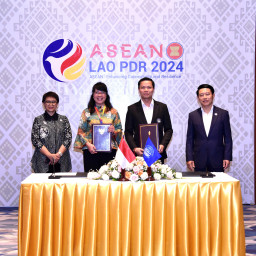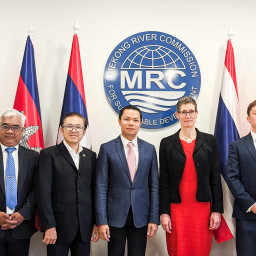Mekong’s higher turbidity likely caused by heavy rainfall
28 January 2014, Vientiane, Lao PDR— Unusually high rainfall is the most likely cause of a recently observed increase in sediment concentrations in large parts of the Lower Mekong Basin but the trend is decreasing, according to a preliminary analysis of the Mekong River Commission.
Following recent reports of increasingly turbid water, the MRC conducted desk and field studies between 17 – 22 January by collecting water samples and analysing measured water levels in the Mekong stretches in Southern Laos and northern Cambodia as well as the mouth of the Sekong River, a tributary of the Mekong.
Preliminary findings suggest that the turbidity was likely caused by extremely high runoff and consequent rising water levels due to strong rainfall events in mid-December 2013. Turbidity usually increases sharply during heavy rainfall when particles from the soil surface are washed into the river and the river bed sediment is re-suspended.
According to the MRC’s preliminary assessment, there is no indication so far that the observed sediment concentrations and turbidity levels were higher than what is usually experienced during the wet season but they are indeed unprecedented for the dry season based on MRC records.
The highest turbidity values found during the recent MRC field studies were approximately 60 NTU (nephelometric turbidity units) with a decreasing trend in the downstream direction. The turbidity is now close to normal for this time of the year.
In Lao PDR, turbidity levels of up to 3,000 NTU are sometimes encountered and usually accepted in raw water production for domestic consumption during the wet season. However, there were reports from some local residents in Cambodia that they could not use the water for immediate cooking or drinking during the recent incident. Some residents in Lao PDR said highly turbid water caused an itchy rash.
The MRC is conducting a laboratory analysis of the water samples to determine the total suspended solids concentration (content of the sediment)
Notes to editors:
The MRC is the intergovernmental body responsible for cooperation on the sustainable management of the Mekong Basin whose members include Cambodia, Lao PDR, Thailand and Viet Nam. It is established to promote cooperation amongst the Member Countries and thus it is not a supra-national or regulatory body.
In dealing with this challenge, the commission looks across all sectors including sustaining fisheries, identifying opportunities for agriculture, maintaining the freedom of navigation, flood management and preserving important ecosystems. Superimposed on these are the future effects of more extreme floods, prolonged drought and sea level rise associated with climate change. In providing its advice, the MRC aims to facilitate a broad range of dialogue among governments, the private sector and civil society.
The MRC Secretariat provides technical, advisory and administrative services to the member states. It facilitates regional meetings of the Member Countries and provides technical advice on joint planning, coordination and cooperation. It also works closely with the four countries’ coordinating bodies, the National Mekong Committees (NMCs), and other state agencies. Currently, the People’s Republic of China and the Union of Myanmar are engaged as MRC Dialogue Partners.
-END-




